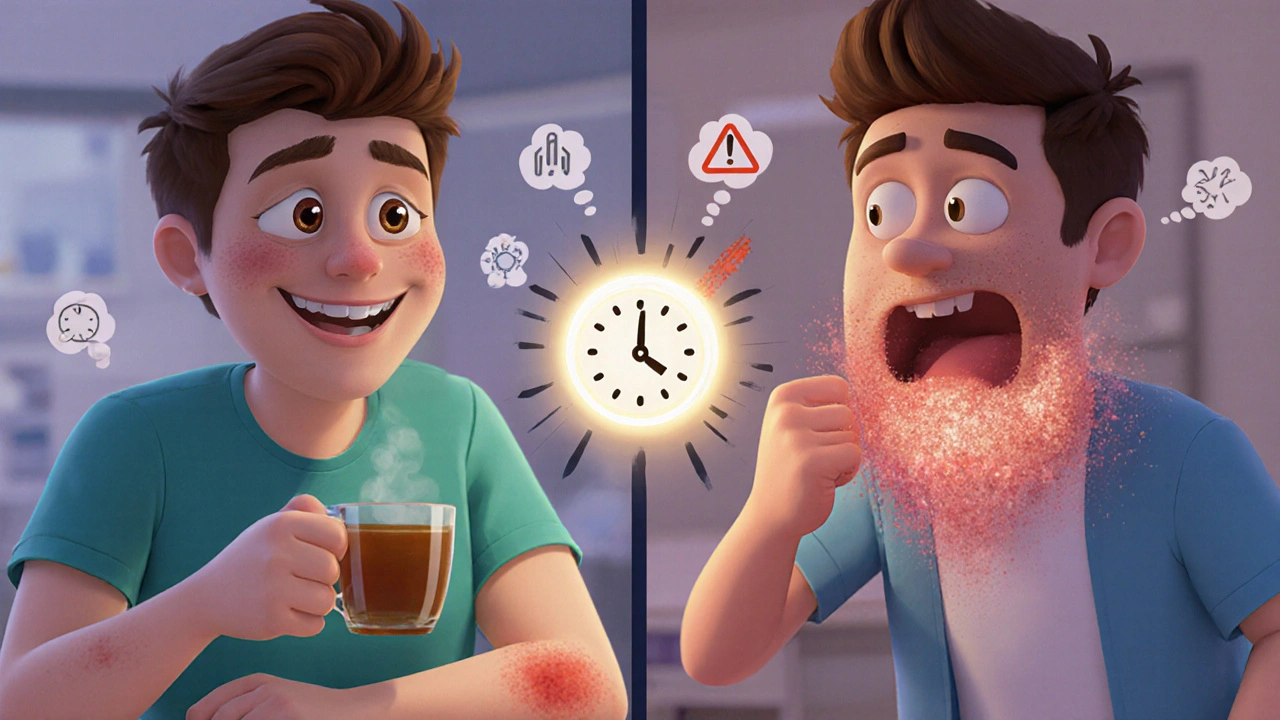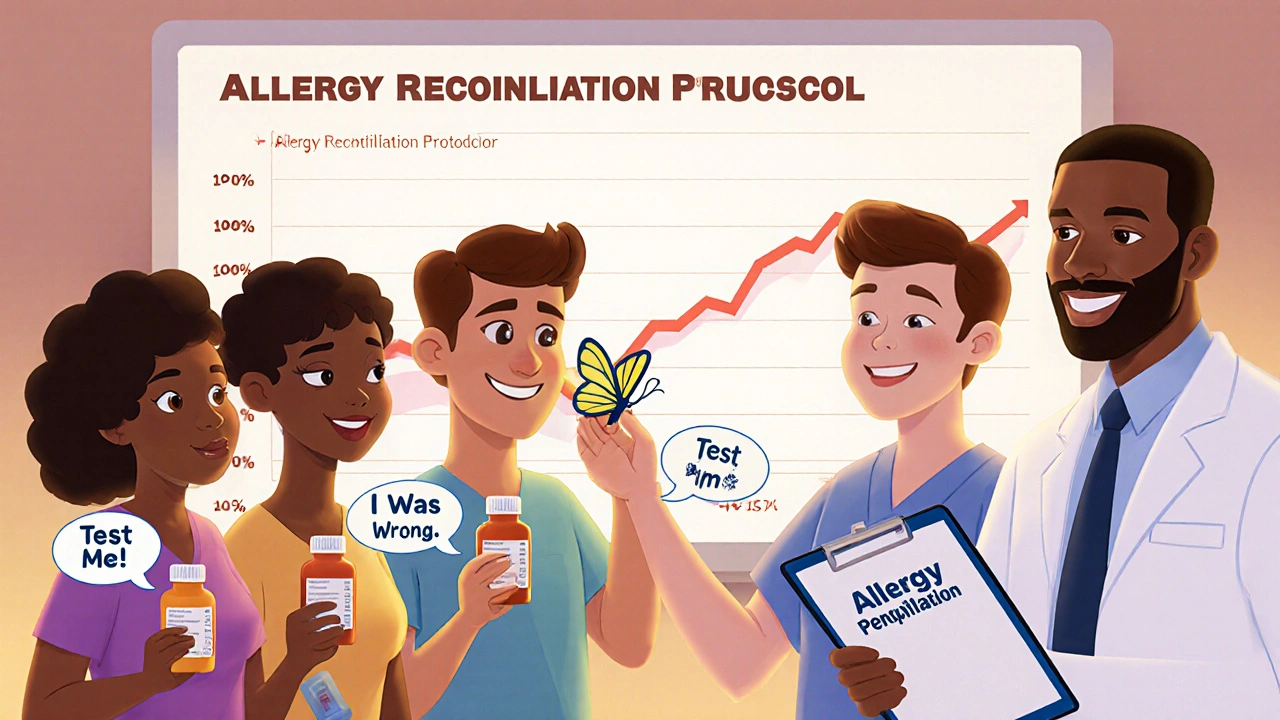Why It Matters Whether You Say ‘Side Effect’ or ‘Allergy’
When you start a new medication, something might feel off. Maybe your stomach hurts. Maybe you break out in a rash. Maybe you feel dizzy. You might think: ‘I’m allergic to this.’ But that’s not always true. And mixing up side effects with allergies can actually put your health at risk.
Side effects are common, predictable reactions to medicine. They don’t mean your immune system is attacking the drug. Allergies do. A true allergy triggers your immune system - even with a tiny dose. And once you’re labeled as allergic to a drug, doctors avoid it for good. That’s a problem if you never had an allergy to begin with.
For example, about 10% of Americans say they’re allergic to penicillin. But studies show 90% of them can safely take it after proper testing. Why? Because they confused a rash or upset stomach with an allergy. That mislabeling leads to stronger, broader antibiotics being used instead - which fuels antibiotic resistance. It’s not just about your own health. It affects everyone’s.
How to Tell the Difference Between Side Effects and Allergies
Here’s the simplest way to spot the difference:
- Side effects usually show up within hours or days of starting the medicine. They’re often mild and may fade after a week or two. Think: nausea from antibiotics, drowsiness from antihistamines, or headaches from blood pressure meds. These happen because the drug affects more than just its target. They’re not dangerous for most people - just annoying.
- Allergic reactions come on fast - often within minutes to a few hours. They involve your immune system. Symptoms include hives, swelling of the lips or tongue, trouble breathing, wheezing, or a sudden drop in blood pressure. These are medical emergencies. If you have any of these, stop the medicine and get help right away.
One big clue? Timing and repetition. If you took the same medicine before and had the same symptom, it’s likely a side effect. If you’ve never had it before, and it came on suddenly with swelling or breathing trouble, it’s more likely an allergy.
And here’s something many don’t realize: side effects often get better as your body adjusts. About 60-70% of initial side effects disappear within 2-4 weeks. Allergies don’t. They get worse with each exposure.
What to Say to Your Doctor - Word for Word
Doctors are busy. They don’t always ask the right questions. You need to lead the conversation. Don’t say: ‘I think I’m allergic.’ Instead, use clear, specific language.
Try this script:
- Describe the symptom exactly: ‘I got a rash on my arms and chest.’ Not ‘I broke out.’
- Pinpoint the timing: ‘It started 3 hours after I took my first dose.’
- Link it to the medicine: ‘It only happened after I started taking amoxicillin.’
- Ask the key question: ‘Is this a known side effect, or could this be an allergic reaction?’
- Follow up: ‘Are there other antibiotics I could take that aren’t in the same family?’
That’s it. No jargon. No guessing. Just facts.
Research from UC San Diego shows patients who use this exact format are 37% more likely to get the right diagnosis. Why? Because it gives your doctor a clear picture. They can check databases, compare symptoms, and decide if you need testing - or just reassurance.

Bring This to Your Appointment
Memory is unreliable. You won’t remember everything. So prepare ahead.
Start a simple symptom log - even just on your phone. For each medication you take, write down:
- Drug name and dose
- Date and time you took it
- Symptom (be specific: ‘itchy red bumps,’ not ‘felt weird’)
- When it started after taking the drug
- How bad it was (1-10 scale)
- Did it get better or worse over time?
Take this log to your appointment. It’s more powerful than you think. A Johns Hopkins study found that using this method improves provider understanding by 41%. And it cuts down on guesswork.
Also, bring your actual medicine bottles. Don’t just say ‘the blue pill.’ Show them. A UCLA Health study showed that physical verification reduces communication errors by 28%. Sometimes, patients mix up names or doses. Seeing the label clears it up instantly.
What If You’re Not Sure? Ask for Testing
Not every rash is an allergy. Not every stomach ache means you can’t take the drug again. But if you’re unsure, ask: ‘Can I be tested to confirm if this is a true allergy?’
For penicillin and a few other drugs, simple skin tests or blood tests can tell you for sure. If the test is negative, you can safely take the drug again. That opens up better, cheaper, and more effective treatment options.
Many people avoid penicillin because they had a rash as a kid - but that rash was probably viral, not allergic. Now, they’re stuck with stronger antibiotics that cost more and increase your risk of C. diff infections or antibiotic resistance.
The American Academy of Allergy, Asthma & Immunology recommends all patients with a history of ‘penicillin allergy’ get evaluated, especially if they’ve never had a severe reaction. The test is quick, safe, and covered by most insurance.

What Happens When You Don’t Speak Up
Delaying or mislabeling reactions has real consequences.
A Kaiser Permanente survey found that 52% of patients waited over five days to report side effects because they weren’t sure if it was ‘serious enough.’ That delay can turn a manageable side effect into something worse - like dehydration from vomiting or a fall from dizziness.
And here’s the hidden cost: mislabeling allergies adds $1,200 to $2,500 per person per year in extra healthcare costs. Why? Because doctors choose more expensive, broader-spectrum antibiotics. They order more lab tests. They monitor you longer. All because the original drug was wrongly labeled as unsafe.
It’s not just about money. It’s about getting the best treatment. If you’re allergic to penicillin - and you really are - then avoiding it makes sense. But if you’re not? You’re missing out on one of the safest, most effective antibiotics ever made.
Tools That Help You Stay on Track
You don’t have to do this alone.
The American Pharmacists Association launched a free app called the Medication Reaction Tracker in January 2023. It walks you through questions to help you distinguish side effects from allergies. It even lets you export your log to share with your doctor. Over 87,000 people have downloaded it.
Also, check the medication guide that comes with your prescription. Since 2023, the FDA requires these guides to clearly separate common side effects from allergic reaction symptoms. Look for bold headings like: ‘Stop this medicine and call your doctor right away if you experience…’
Some clinics now use a standard checklist called the Allergy Reconciliation Protocol. If your provider doesn’t mention it, ask: ‘Do you use a system to check if my allergy labels are accurate?’
Final Tip: Don’t Let Labels Stick
Once you’re labeled as allergic to a drug, it stays in your record - forever. Even if you were wrong.
That’s why it’s so important to get it right the first time. If you think you had an allergic reaction, don’t assume. Ask for testing. If you had a side effect, don’t panic. Track it. Talk about it. Give your body time to adjust.
Medicines are powerful. But so is your voice. You’re not just a patient. You’re the person who knows your body best. Use that knowledge. Ask the right questions. And make sure your care team hears you clearly.
How do I know if my rash is a side effect or an allergy?
A side effect rash usually appears days after starting the medication, is mild, and may fade over time. An allergic rash appears quickly - often within hours - and is often raised, itchy, and spreads. If you also have swelling, trouble breathing, or dizziness, it’s likely an allergy. Always report it to your doctor, but be specific about timing and symptoms.
Can I outgrow a drug allergy?
True drug allergies don’t usually go away on their own. But many people are mislabeled. If you were told you’re allergic to penicillin as a child and never had a severe reaction, you may not be allergic at all. Testing can confirm this. About 90% of people who think they’re allergic to penicillin can safely take it after evaluation.
What should I do if I think I’m having an allergic reaction?
Stop taking the medication immediately. If you have swelling of the face, lips, or throat; trouble breathing; or feel faint, call emergency services or go to the nearest ER. Do not wait. Even if symptoms seem mild at first, they can worsen quickly. Afterward, schedule an appointment with your doctor or an allergist to get tested.
Why do doctors sometimes prescribe stronger antibiotics if I say I’m allergic to penicillin?
Penicillin is one of the safest and most effective antibiotics. If your record says you’re allergic, doctors avoid it - even if you’re not truly allergic. They then use broader-spectrum antibiotics, which are more expensive, have more side effects, and contribute to antibiotic resistance. That’s why accurate labeling matters - for your health and for public health.
Can I bring my own symptom log to my doctor?
Yes - and you should. Studies show patients who bring written logs of symptoms, timing, and severity are 37% more likely to get accurate diagnoses. Your log doesn’t need to be fancy. Just note the drug, dose, symptom, when it started, and how long it lasted. It saves time and helps your doctor make better decisions.

